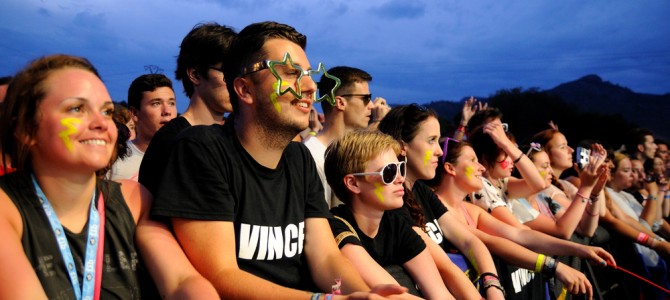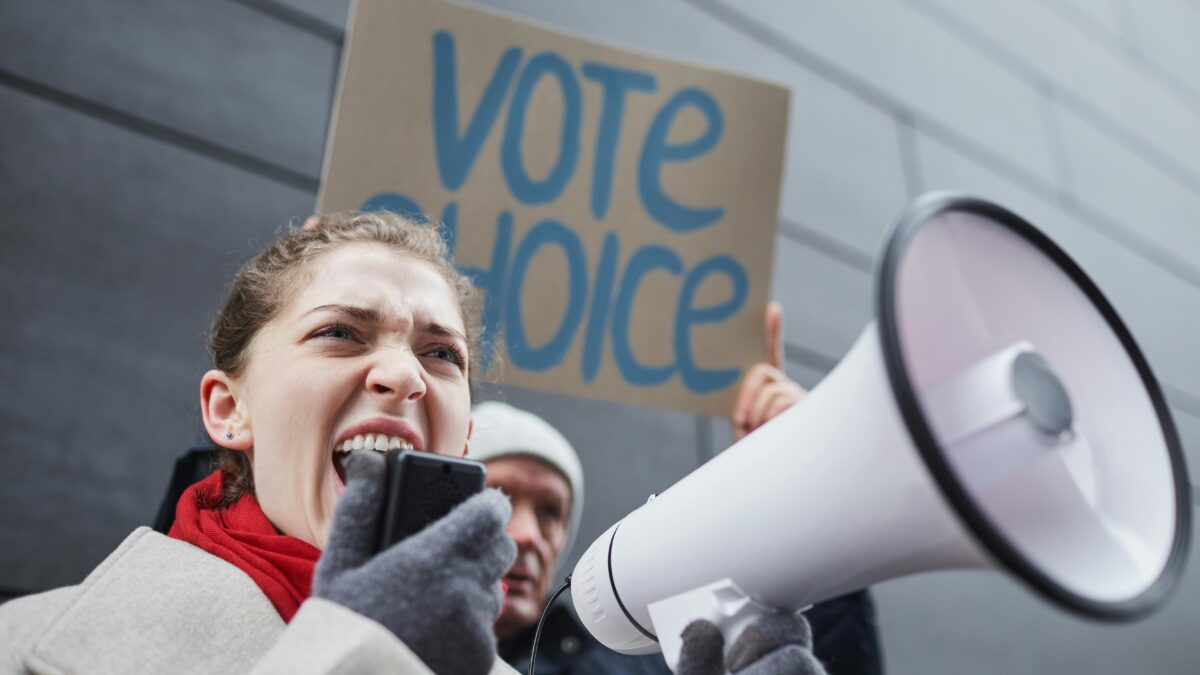
Last year at SXSW, a drunk driver plowed into a crowd while fleeing the police, injuring dozens and leaving four dead. The next morning, festival officials declared that the show would go on, and it did. That very night, in what has become a fitting symbol of SXSW, Lady Gaga performed on a five-story-tall Doritos vending machine stage.
The grisly hit-and-run—the first such incident in 27 years of SXSW—is a macabre reminder of how unhinged the festival can be, but it doesn’t quite convey the essence of what SXSW has become. Not like the giant Lady Gaga Doritos stage does.
What began in 1987 as a regional music expo hosted by The Austin Chronicle, a local alt-weekly rag that wanted to help unknown bands from the South get noticed by record labels on the coasts, is now the international marketing event par excellence, drawing hundreds of thousands of people to Austin, Texas, every March for an extended bacchanal. Whatever it might have been, SXSW is now a sprawling, weeks-long interactive marketing bonanza for major brands, well-funded startups, and the many miens of the entertainment industry. There’s also some live music.
Lest this seem like the rant of some curmudgeonly Austinite, let me just say that, yes, I realize griping about the corporatization of SXSW has become a thing over the last couple of years. So has declaring SXSW to be over. So has declaring that “declaring ‘SXSW is over’ is over.” Being over SXSW, and being over being over SXSW, and talking about it at SXSW, is all the rage:
SXSW needs more industry panel discussions about SXSW industry panel discussions
— David Burge (@iowahawkblog) March 12, 2015
I get it. SXSW is what it is. (Full disclosure: My erstwhile band performed at SXSW in 2010 as part of an event hosted by HitRecord, a collaborative production company founded by the actor Joseph Gordon-Levitt. We were paid fairly, had a blast, and have no regrets.)
SXSW Should Move Cities
But here’s the thing: SXSW should move to a larger city, and it doesn’t matter where. Big brands are by definition placeless, and SXSW is irresistible to big brands. Doritos, after erecting that giant vending machine for Lady Gaga last year and paying $2.5 million for a lackluster performance, opted out of a high-profile role at this year’s festival—only to be replaced by McDonalds.
It hardly matters that these large companies sometimes don’t fully grasp what SXSW is supposed to pretend to be, hence the spectacle this year of McDonalds asking some Brooklyn indie band to perform at their showcase for free and offering to pay them in burgers. The band’s response on Facebook went viral and prompted McDonalds to change its mind, but the tumult quickly passed. Bands were booked, attendees got free burgers, and McDonalds got to “interact” with its customers. It also set up a food truck.
The frequency with which this sort of thing now happens at SXSW underscores a kind of aimlessness about the entire affair. One gets the sense that SXSW isn’t really about anything in particular. This year, the festival is hosting every genre of band from nearly every continent, films great and small, a bunch of panels with pharmaceutical companies, the General Electric BBQ Research Center, Al Gore on the perils of climate change, Paul Krugman on a panel with the Arcade Fire brothers, a Tinder bot, a fake anti-robot protest staged by a rival dating app, a fake Bates Motel, Iron Throne pedicabs, and a flying car.
An independent report commissioned by SXSW after last year’s fatal hit-and-run suggested that perhaps the festival is getting too big for the city. “If SXSW cannot sustain success and growth in the future, like any business they will eventually need to make decisions about whether or not they can continue to exist in their current format and location,” the report said. “It is very possible that SXSW will have no choice but to entertain notions of bidding their event to other cities to sustain their business model.” The report caused a stir in part because the festival is big business for the city. SXSW’s economic impact last year on Austin was $315 million, with a cumulative attendance of more than 376,000, counting all of its iterations: music, film, interactive, SXSW Edu, and SXSW Eco.
But the convergence of industries and brands that produces those metrics is precisely what’s rendered SXSW placeless and aimless. The festival has little need for Austin. It could be staged in almost any large city anywhere in the world, and attendees and sponsors would hardly notice. Between the McDonalds Lounge, the Capital One acoustic stage, Mazda’s “activations,” and the offerings of 547 other companies, Austin itself is inconsequential. At best, the city’s reputation for being the “Live Music Capitol of the World” has become just another marketing ploy in a festival that’s mostly about marketing.
It’s Just a Gimmick to Reach Millennials
SXSW co-founder and managing director Roland Swenson disagrees, of course. After the report hinted that the festival might need to consider moving, he told the Austin American-Statesman: “SXSW is so tied up in Austin and we reflect each other so much that I can’t really imagine that happening.” But it’s hard to see how SXSW reflects anything besides the awkward attempts of corporate brands to reach millennials.
In that sense, it doesn’t reflect a place so much as a façade. Companies want to associate themselves with SXSW because it’s cool and edgy, so they set up stages and hire bands and go all-out to showcase their brand, and in the process they render the place itself unrecognizable. For the purposes of SXSW, Austin might as well be a blank canvas.
On some level, Swenson must sense this. At times he sounds like a man who’s stumbled upon a rather profitable scheme but isn’t quite sure what any of it means or what to do next. In a recent Q&A with Texas Monthly, Swenson was candid about the mercenary nature of his creation:
It gets more expensive every year, even just to stay at the same size, so growth doesn’t necessarily mean more bodies, but it does mean that we need to make more money every year to keep everything afloat. Something we learned is that any event that is not growing is dying. We’ve seen that happen. So do we want to grow? Sure, in some ways, like the things I was telling you about—space exploration, medicine, what we’ve done with SXSWEdu—there’s a lot of areas we want to pursue.
As SXSW Goes, So Goes American Culture
To those who complain that SXSW has grown too big, Swenson counters that “there’s still a lot of stuff that’s just not us.” Officially, SXSW isn’t actually growing much anymore, he says, but unofficial events proliferate. This is also his answer when asked about the ubiquity of brands, as if SXSW had nothing to do with creating the ideal venue for large-scale, simultaneous corporate marketing events.
But maybe it’s not fair to pick on Swenson. After all, the evolution of SXSW reflects a larger cultural trend toward homogeneity in American culture. Consider how regional differences in music have all but disappeared in recent decades. It used to be that Chicago blues was distinct from Mississippi blues. Jazz in the northeast was different than in Dixieland. In literature, authors like John Steinbeck, John Fante, and Nathaniel West reflected the landscape and social milieu of the west coast, while William Faulkner, Walker Percy, and Flannery O’Connor were inseparable from the south.
But you don’t even have to go that far back. Willie Nelson, Townes Van Zandt, and Waylon Jennings helped create Texas “outlaw country” by reacting to the more polished Nashville sound with a gritty realism that caught on. At the first-ever SXSW in 1987, one of the biggest acts was an outlaw country group from Austin, the Jimmie Gilmore Band, which headlined opening night at the Continental Club.
A lot has changed since then. Last year, the biggest show at SXSW was the Samsung Galaxy® Concert Series with Jay-Z and Kanye West. This year, Kanye will be a guest on “Jimmy Kimmel Live,” which is filming in Austin for SXSW for the second year in a row. Rumor is, he might perform with Drake.









